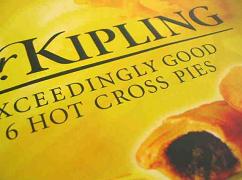Good Friday in the UK is traditionally marked by the consumption of Hot Cross Buns. The Telegraph gave us some background back in 2003:
The tradition dates back to pagan times when the cross represented the moon and its four quarters. It was claimed for the Christian church in 1361 when Father Thomas Rockcliffe distributed the buns to the poor of St Albans.
It became traditional to eat the buns on Good Friday after Elizabeth I passed a law limiting their consumption to religious festivals.
(Wikipedia currently states that this latter detail is an “urban myth”)
Christmas in the UK is traditionally marked by the consumption of “mince pies”. History Online explains:
Three centuries ago, a mince pie was a huge dish called “Christmas pye” and described as “a most learned mixture of Neats-tongues (ox tongue), chicken, eggs, sugar, raisins, lemon and orange peel, various kinds of spicery, etc.” Over the years, the pies grew smaller, and the meat content was gradually reduced until the pies were simply filled with a mixture of suet, spices and dried fruit, previously steeped in brandy. This filling was put into little pastry cases that were covered with pastry lids and then baked in an oven. Essentially, this is today’s English mince pie.
But now, cake manufacturer Mr Kipling brings us the patented Hot Cross Mince Pie:

Apparently these came out last year, while I was in Japan. Meanwhile, Polly Toynbee comments in today’s Guardian:
The DJ wasn’t joking when he burbled: “Happy Good Friday!” His audience probably didn’t wince, since a recent poll showed that 43% of the population have no idea what Easter celebrates, with the young most clueless. Eggs, bunnies, lambs?
Next year: chocolate-flavoured Passover matzos…
(Pic via Heuristic Blog)
Filed under: Uncategorized



Glad you liked the pic ;)
I didn’t realise it was patented, it’s all quite ridiculous.